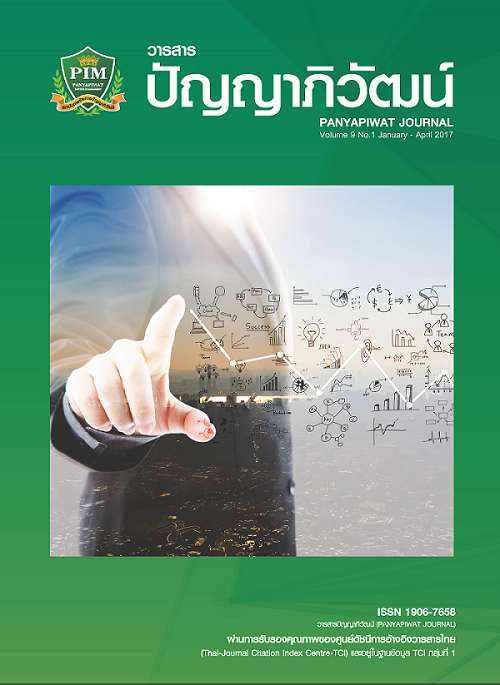การสังเคราะห์งานวิจัยเกี่ยวกับความผูกพันต่อองค์การของพนักงานภาคเอกชน
Main Article Content
บทคัดย่อ
การวิจัยในครั้งนี้เป็นการสังเคราะห์งานวิจัยเกี่ยวกับความผูกพันต่อองค์การ โดยมีกลุ่มตัวอย่างในการวิจัยเป็นวิทยานิพนธ์ หรือปริญญานิพนธ์ของนิสิต/นักศึกษาระดับมหาบัณฑิตและดุษฎีบัณฑิต จากมหาวิทยาลัยภาครัฐและเอกชนในกำกับของสำนักงานคณะกรรมการการอุดมศึกษา (สกอ.) จำนวน 14 แห่ง ที่ตีพิมพ์ระหว่างปี พ.ศ. 2548-2557 จำนวน 43 เล่ม โดยใช้เครื่องมือการวิจัยจำนวน 2 ชุดในการเก็บรวมรวมและวิเคราะห์ข้อมูล ผลการวิจัยพบว่า งานวิจัยเกี่ยวกับความผูกพันต่อองค์การของพนักงานภาคเอกชน มีคุณลักษณะของงานวิจัย 4 ด้าน ประกอบด้วย 1) ด้านคุณลักษณะงานวิจัย 2) ด้านเนื้อหาสาระของงานวิจัย 3) ด้านระเบียบวิธีวิจัย และ 4) ด้านคุณภาพของงานวิจัย ทั้งนี้ ผู้วิจัยได้สังเคราะห์งานวิจัยด้วยเทคนิคการวิเคราะห์เนื้อหา (Content Analysis) และได้สรุปองค์ความรู้เกี่ยวกับความผูกพันต่อองค์การของพนักงานภาคเอกชน จำนวน 7 ประเด็น ได้แก่ 1) วัตถุประสงค์การวิจัย 2) ทฤษฎีและแนวคิดที่เกี่ยวข้อง 3) ปัจจัยที่ส่งผลต่อความผูกพันต่อองค์การ 4) ประเภทธุรกิจของกลุ่มตัวอย่างที่ใช้ในการวิจัย 5) ระเบียบวิธีวิจัย 6) คุณภาพของงานวิจัย และ 7) การเสนอแนะเรื่องการสร้างความผูกพันต่อองค์การจากงานวิจัย
การสังเคราะห์งานวิจัยในครั้งนี้จะเป็นประโยชน์สำหรับผู้ที่สนใจศึกษาเรื่อง ความผูกพันต่อองค์การและประยุกต์ใช้ในการบริหารจัดการในองค์การ รวมถึงเป็นแนวทางในการกำหนดประเด็นการศึกษาต่อยอดองค์ความรู้เกี่ยวกับเรื่องความผูกพันต่อองค์การต่อไป
The research was to synthesize the research on the research about employee engagement of private sector employees. A sample of the selection criteria is 43 research; thesis or dissertation of students/graduates and doctoral students from 14 public and private universities under the supervision of the office higher education that were published during 2005 - 2014. There are two sets of tools used for data collection. The research showed 4 parts of result that 1) Characteristic of the research 2) The content of the research 3) The research method 4) The quality of research. Besides, Results of the research synthesis techniques to analyze the content (Content Analysis), researchers can infer knowledge about important research on the employee engagement of private sector employees at all seven issues include: 1) knowledge about the purpose of the research 2) knowledge of the theory and concepts involved 3) knowledge about The factors that influenced the employee engagement 4) knowledge about the types of Business samples used in the research. 5) knowledge about the research method 6) knowledge of the quality of research and 7) knowledge about the recommendations for creating employee engagement.
Article Details
“ข้าพเจ้าและผู้เขียนร่วม (ถ้ามี) ขอรับรองว่า บทความที่เสนอมานี้ยังไม่เคยได้รับการตีพิมพ์และไม่ได้อยู่ระหว่างกระบวนการพิจารณาลงตีพิมพ์ในวารสารหรือแหล่งเผยแพร่อื่นใด ข้าพเจ้าและผู้เขียนร่วมยอมรับหลักเกณฑ์การพิจารณาต้นฉบับ ทั้งยินยอมให้กองบรรณาธิการมีสิทธิ์พิจารณาและตรวจแก้ต้นฉบับได้ตามที่เห็นสมควร พร้อมนี้ขอมอบลิขสิทธิ์บทความที่ได้รับการตีพิมพ์ให้แก่สถาบันการจัดการปัญญาภิวัฒน์หากมีการฟ้องร้องเรื่องการละเมิดลิขสิทธิ์เกี่ยวกับภาพ กราฟ ข้อความส่วนใดส่วนหนึ่งและ/หรือข้อคิดเห็นที่ปรากฏในบทความข้าพเจ้าและผู้เขียนร่วมยินยอมรับผิดชอบแต่เพียงฝ่ายเดียว”
References
Blessing White. (2013). Employee Engagement. Retrieved July 13, 2015, from https://blessingwhite.com/wp-content/uploads/2014/06/Employee-Engagement-Research-Report-2013.pdf
Buchanan, B. (1974). Building Organizational Commitment: The Socialization of Managers in Work Organizations. Administrative Science Quarterly, 19(4), 533-546.
Burke. (2003). Employee Engagement Surveys. Retrieved June 20, 2014, from http://employeeresearch.burke.com/index.cfm?id=230&spgid=82
Chunlachat, T. (2013). The labor market changes, New era organizations must reconcile employee.Retrieved August 19, 2013, from http://www.haygroup.com/th/press/details.aspx?id=38294 [in Thai]
Gadharn, T. (2011). Organization commitment of employee engagement at Far East peerless (Thailand) 1968 Co., Ltd. Master of Education, Faculty of Human Resource Development, Ramkhamhaeng University. [in Thai]
Gallup. (2013). The State of the Global Workplace: Employee Engagement Insights for Business Leaders Worldwide. Retrieved August 15, 2014, from http://www.securex.be/export/sites/default/.content/download-gallery/nl/brochures/Gallup-state-of-the-GlobalWorkplaceReport_20131.pdf
Hay Group. (2011). Feedback report - Employee effectiveness Organization report. Retrieved July 18, 2015, from https://www.haygroup.com/downloads/th/EE_Organization_Sample_111010.pdf
Herzberg, F. (1959). Two - Factors Theory. Retrieved July 17, 2014, from http://www.businessballs.com/herzberg.html
Heskett, J. L., Jones, T. O., Loveman, G. W., Sasser, W. E. Jr. & Schlesinger, L. A. (1994). Putting the Service-Profit Chain to Work. Retrieved August 1, 2016, from https://hbr.org/2008/07/putting-the-service-profit-chain-to-work
Hewitt, A. (2014). 2014 Trends in Global Employee Engagement. Retrieved October 10, 2014, from http://www.aon.com/attachments/human-capital-consulting/2014-trends-in-global-employee-engagement-report.pdf
HR Revolution. (2012). Costs About the resignation. Retrieved September 25, 2014, from https://humanrevod.wordpress.com/2012/02/15/turnover-cost/ [in Thai]
Institute for Employee Studies. (2004). The drivers of employee engagement. Retrieved August 25, 2014, from http://www.employment-studies.co.uk/system/files/resources/files/408.pdf
International Survey Research. (2004). Engaged employees drive the bottom line. Retrieved August 15, 2014, from http://www.isrinsight.com/pdf/solutions/EngagementBrochureFinalUS.pdf
Kahn, W. A. (1990). Psychological Conditions of Personal Engagement and Disengagement at Work. Academy of Management Journal, 33(4), 692-724.
Labour market research division, Department of employment. (2015). Unemployment situation Termination of employment and labor requirements. Retrieved September 25, 2015, from http://lmi.doe.go.th/images/file/unemployment/unemployment_0758.pdf [in Thai]
Nuchapong, W. (2010). Organizational Commitment: A case study of Jasmine Group Companies.Master of Business Administration, Faculty of General Management, Ramkhamhaeng University. [in Thai]
Sariputta, B. & Boonsong, K. (2015). Employee Engagement: A case study of Bill Payment XYZ Company limited. Panyapiwat Journal, 7(Special Issue), 213-226. [in Thai]
Steers, R. M. (1977). Antecedents and Outcomes of Organizational Commitment. Administrative Science Quarterly, 22(1), 46-56.
Suthammanon, L. & Osathanugrah, K. (2015). Employee Engagement Model. A case study of Bill Payment Service Business XYZ Company limited. Panyapiwat Journal, 7(2), 96-107. [in Thai]
Suwannawej, S. (2006). Developing Employee Engagement Model. Master of Science (Human Resource development), National Institute of Development Administration. [in Thai]
Tower Watson. (2012). Global Workforce Study. Engagement at risk: Driving Strong Performance in a volatile Global Environment. Retrieved November 17, 2014, from https://www. philanthropyohio.org/sites/default/files/resources/2012-Towers-Watson-Global-Workforce-Study.pdf
Unahalekhaka, A. (2006). Factors affecting organizational commitment of National Intelligence Agency Employee. Master of Public Administration, Sukhothai Thammathirat Open University. [in Thai]
Xu, Y. & Goedegebuure, R. (2005). Employee Satisfaction and Customer Satisfaction: Testing the Service-Profit Chain in a Chinese Securities firm. Innovative Marketing, 1(2), 49-59.
Yawanangkul, W. (2006). Organizational Commitment of National Finance Employees at the Head Quarter. Master of Arts, Faculty of Political Sciences, Kasetsart University. [in Thai]

